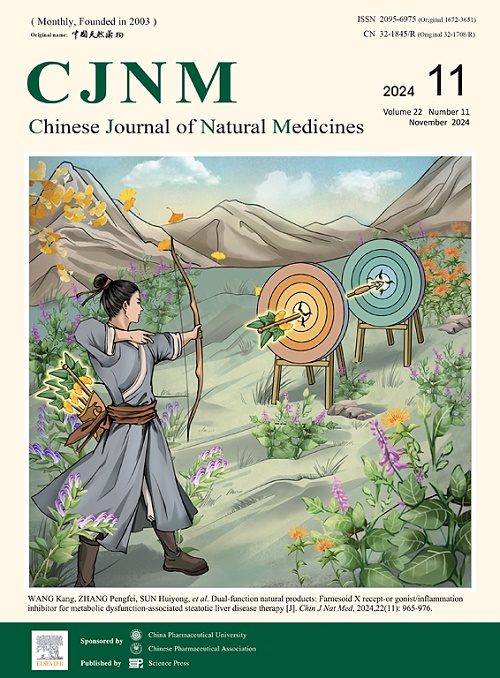Combination of Astragalus−Salvia and Ophiopogon−Dendrobium herb pairs alleviates Sjögren’s Syndrome via inhibiting the JAK1/STAT3 and PI3K/AKT pathways in NOD/Ltj mice
IF 4.9
2区 医学
Q1 INTEGRATIVE & COMPLEMENTARY MEDICINE
引用次数: 0
Abstract
Sjögren’s syndrome (SS) is an autoimmune disease characterized primarily by oral and periocular dryness. Astragalus-Salvia (AS) and Ophiopogon-Dendrobium (OD) represent two frequently utilized herb pairs in SS treatment. While the combination of AS-OD herb pairs demonstrates clinical efficacy in alleviating SS symptoms, its underlying mechanism remains unclear. This investigation sought to assess the therapeutic effects and elucidate the potential mechanisms of AS-OD in non-obese diabetic (NOD)/Ltj mice with SS. The study utilized NOD/Ltj mice as SS models, administering AS-OD treatment for 10 weeks at doses of 113.1, 226.2, and 339.3 mg·d−1·20 g−1. Results demonstrated that AS-OD improved SS symptoms, evidenced by enhanced salivary flow rate, decreased anti-SSA/Ro and anti-SSB/La antibody levels, increased swimming duration, and reduced lactate (LA) and blood urea nitrogen (BUN) levels in NOD/Ltj mice. AS-OD reduced lymphocyte infiltration, enhanced Aquaporin-5 (AQP5) expression in the submandibular gland, decreased inflammatory cytokine levels in the submandibular gland, and reduced the T helper type 17/regulatory T lymphocyte (Th17/Treg) cell ratio in the spleen. Transcriptomic and proteomic analyses indicated AS-OD’s involvement in regulating phosphatidylinositol-3-kinase/protein kinase B (PI3K/AKT) and Janus kinase 3/signal transducer and activator of transcription 3 (JAK1/STAT3) pathways, with inhibitory effects validated in both NOD/Ltj mice submandibular gland and A-253 cells. Furthermore, AS-OD enhanced cell viability and reduced A-253 cell apoptosis through the PI3K/AKT pathway. In A-253 cells, AS-OD reduced inflammatory cytokine levels, CXC chemokine ligand 9/10 (CXCL9/10), and T-cell chemotaxis by inhibiting the JAK1/STAT3 pathway. AS-OD mitigates SS by suppressing inflammation and immune responses through the PI3K/AKT and JAK1/STAT3 pathways.
黄芪-鼠尾草和麦冬-石斛组合通过抑制NOD/Ltj小鼠的JAK1/STAT3和PI3K/AKT通路减轻Sjögren 's综合征
Sjögren综合征(SS)是一种以口腔和眼周干燥为主要特征的自身免疫性疾病。黄芪-鼠尾草(AS)和麦冬-石斛(OD)是SS治疗中常用的两对草本植物。虽然AS-OD中药组合在缓解SS症状方面具有临床疗效,但其潜在机制尚不清楚。本研究旨在评估as - od对患有SS的非肥胖糖尿病(NOD)/Ltj小鼠的治疗效果,并阐明其潜在机制。本研究以NOD/Ltj小鼠作为SS模型,分别以113.1、226.2和339.3 mg·d - 1·20 g - 1剂量给予as - od治疗10周。结果表明,AS-OD改善了NOD/Ltj小鼠的SS症状,表现为唾液流速增加,抗ssa /Ro和抗ssb /La抗体水平降低,游泳时间延长,乳酸(La)和血尿素氮(BUN)水平降低。AS-OD可减少淋巴细胞浸润,增强颌下腺水通道蛋白-5 (AQP5)表达,降低颌下腺炎性细胞因子水平,降低脾脏T辅助型17/调节性T淋巴细胞(Th17/Treg)细胞比例。转录组学和蛋白质组学分析表明,AS-OD参与调节磷脂酰肌醇-3激酶/蛋白激酶B (PI3K/AKT)和Janus激酶3/信号转导和转录激活因子3 (JAK1/STAT3)通路,在NOD/Ltj小鼠颌下腺和A-253细胞中均有抑制作用。此外,AS-OD通过PI3K/AKT通路增强细胞活力,减少A-253细胞凋亡。在A-253细胞中,AS-OD通过抑制JAK1/STAT3通路降低炎症细胞因子水平、CXC趋化因子配体9/10 (CXCL9/10)和t细胞趋化性。AS-OD通过PI3K/AKT和JAK1/STAT3通路抑制炎症和免疫反应,从而减轻SS。
本文章由计算机程序翻译,如有差异,请以英文原文为准。
求助全文
约1分钟内获得全文
求助全文
来源期刊

Chinese Journal of Natural Medicines
INTEGRATIVE & COMPLEMENTARY MEDICINE-PHARMACOLOGY & PHARMACY
CiteScore
7.50
自引率
4.30%
发文量
2235
期刊介绍:
The Chinese Journal of Natural Medicines (CJNM), founded and sponsored in May 2003 by China Pharmaceutical University and the Chinese Pharmaceutical Association, is devoted to communication among pharmaceutical and medical scientists interested in the advancement of Traditional Chinese Medicines (TCM). CJNM publishes articles relating to a broad spectrum of bioactive natural products, leading compounds and medicines derived from Traditional Chinese Medicines (TCM).
Topics covered by the journal are: Resources of Traditional Chinese Medicines; Interaction and complexity of prescription; Natural Products Chemistry (including structure modification, semi-and total synthesis, bio-transformation); Pharmacology of natural products and prescription (including pharmacokinetics and toxicology); Pharmaceutics and Analytical Methods of natural products.
 求助内容:
求助内容: 应助结果提醒方式:
应助结果提醒方式:


